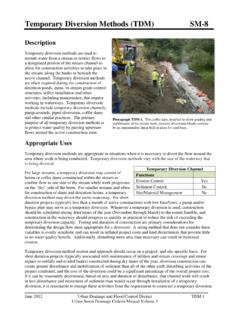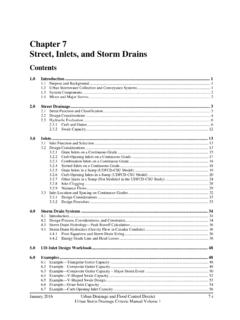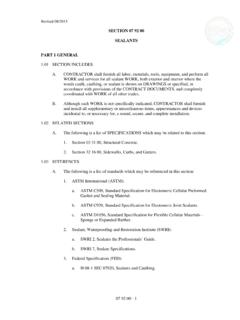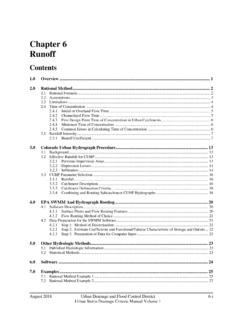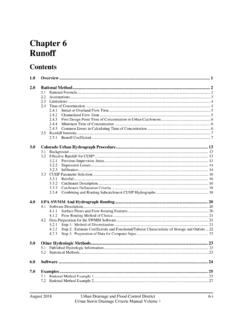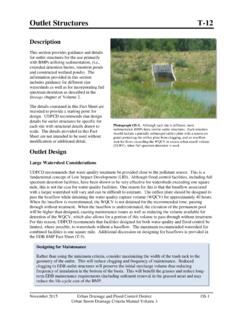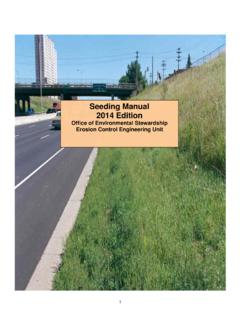Transcription of Construction Phasing/Sequencing (CP) SM-1 - UDFCD
1 Construction Phasing/Sequencing (CP) SM-1 November 2010 Urban Drainage and Flood Control District CP-1 Urban Storm Drainage Criteria manual Volume 3 Photograph CP-1. Construction phasing to avoid disturbing the entire area at one time. Photo courtesy of WWE. Description Effective Construction site management to minimize erosion and sediment transport includes attention to Construction phasing, scheduling, and sequencing of land disturbing activities. On most Construction projects, erosion and sediment controls will need to be adjusted as the project progresses and should be documented in the SWMP. Construction phasing refers to disturbing only part of a site at a time to limit the potential for erosion from dormant parts of a site.
2 Grading activities and Construction are completed and soils are effectively stabilized on one part of a site before grading and Construction begins on another portion of the site. Construction sequencing or scheduling refers to a specified work schedule that coordinates the timing of land disturbing activities and the installation of erosion and sediment control practices. Appropriate Uses All Construction projects can benefit from upfront planning to phase and sequence Construction activities to minimize the extent and duration of disturbance. Larger projects and linear Construction projects may benefit most from Construction sequencing or phasing, but even small projects can benefit from Construction sequencing that minimizes the duration of disturbance.
3 Typically, erosion and sediment controls needed at a site will change as a site progresses through the major phases of Construction . Erosion and sediment control practices corresponding to each phase of Construction must be documented in the SWMP. Design and Installation BMPs appropriate to the major phases of development should be identified on Construction drawings. In some cases, it will be necessary to provide several drawings showing Construction -phase BMPs placed according to stages of development ( , clearing and grading, utility installation, active Construction , final stabilization). Some municipalities in the Denver area set maximum sizes for disturbed area associated with phases of a Construction project. Additionally, requirements for phased Construction drawings vary among local governments within the UDFCD boundary.
4 Some local governments require separate erosion and sediment control drawings for initial BMPs, interim conditions (in active Construction ), and final stabilization. Construction Scheduling Functions Erosion Control Moderate Sediment Control Moderate Site/Material Management Yes SM-1 Construction Phasing/Sequencing (CP) CP-2 Urban Drainage and Flood Control District November 2010 Urban Storm Drainage Criteria manual Volume 3 Typical Construction phasing BMPs include: Limit the amount of disturbed area at any given time on a site to the extent practical. For example, a 100-acre subdivision might be constructed in five phases of 20 acres each. If there is carryover of stockpiled material from one phase to the next, position carryover material in a location easily accessible for the pending phase that will not require disturbance of stabilized areas to access the stockpile.
5 Particularly with regard to efforts to balance cut and fill at a site, careful planning for location of stockpiles is important. Typical Construction sequencing BMPs include: Sequence Construction activities to minimize duration of soil disturbance and exposure. For example, when multiple utilities will occupy the same trench, schedule installation so that the trench does not have to be closed and opened multiple times. Schedule site stabilization activities ( , landscaping, seeding and mulching, installation of erosion control blankets) as soon as feasible following grading. Install initial erosion and sediment control practices before Construction begins. Promptly install additional BMPs for inlet protection, stabilization, etc.
6 , as Construction activities are completed. Table CP-1 provides typical sequencing of Construction activities and associated BMPs. Maintenance and Removal When the Construction schedule is altered, erosion and sediment control measures in the SWMP and Construction drawings should be appropriately adjusted to reflect actual "on the ground" conditions at the Construction site. Be aware that changes in Construction schedules can have significant implications for site stabilization, particularly with regard to establishment of vegetative cover. Construction Phasing/Sequencing (CP) SM-1 November 2010 Urban Drainage and Flood Control District CP-3 Urban Storm Drainage Criteria manual Volume 3 Table CP-1. Typical Phased BMP Installation for Construction Projects Project Phase BMPs Pre-disturbance, Site Access Install sediment controls downgradient of access point (on paved streets this may consist of inlet protection).
7 Establish vehicle tracking control at entrances to paved streets. Fence as needed. Use Construction fencing to define the boundaries of the project and limit access to areas of the site that are not to be disturbed. Note: it may be necessary to protect inlets in the general vicinity of the site, even if not downgradient, if there is a possibility that sediment tracked from the site could contribute to the inlets. Site Clearing and Grubbing Install perimeter controls as needed on downgradient perimeter of site (silt fence, wattles, etc). Limit disturbance to those areas planned for disturbance and protect undisturbed areas within the site ( Construction fence, flagging, etc). Preserve vegetative buffer at site perimeter.
8 Create stabilized staging area. Locate portable toilets on flat surfaces away from drainage paths. Stake in areas susceptible to high winds. Construct concrete washout area and provide signage. Establish waste disposal areas. Install sediment basins. Create dirt perimeter berms and/or brush barriers during grubbing and clearing. Separate and stockpile topsoil, leave roughened and/or cover. Protect stockpiles with perimeter control BMPs. Stockpiles should be located away from drainage paths and should be accessed from the upgradient side so that perimeter controls can remain in place on the downgradient side. Use erosion control blankets, temporary seeding, and/or mulch for stockpiles that will be inactive for an extended period.
9 Leave disturbed area of site in a roughened condition to limit erosion. Consider temporary revegetation for areas of the site that have been disturbed but that will be inactive for an extended period. Water to minimize dust but not to the point that watering creates runoff. SM-1 Construction Phasing/Sequencing (CP) CP-4 Urban Drainage and Flood Control District November 2010 Urban Storm Drainage Criteria manual Volume 3 Project Phase BMPs Utility And Infrastructure Installation In Addition to the Above BMPs: Close trench as soon as possible (generally at the end of the day). Use rough-cut street control or apply road base for streets that will not be promptly paved. Provide inlet protection as streets are paved and inlets are constructed.
10 Protect and repair BMPs, as necessary. Perform street sweeping as needed. Building Construction In Addition to the Above BMPs: Implement materials management and good housekeeping practices for home building activities. Use perimeter controls for temporary stockpiles from foundation excavations. For lots adjacent to streets, lot-line perimeter controls may be necessary at the back of curb. Final Grading In Addition to the Above BMPs: Remove excess or waste materials. Remove stored materials. Final Stabilization In Addition to the Above BMPs: Seed and mulch/tackify. Seed and install blankets on steep slopes. Remove all temporary BMPs when site has reached final stabilization.
